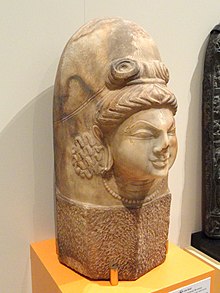Hinduism in Afghanistan
The year 980 C.E. marks the beginning of the Muslim invasion into India proper when Sabuktagin attacked Raja Jaya Pal in Afghanistan. Afghanistan is today a Muslim country separated from India by another Muslim country Pakistan. But in 980 C.E. Afghanistan was also a place where the people were Hindus and Buddhists.
The name “Afghanistan” comes from “Upa-Gana-stan” which means in Sanskrit “the place inhabited by allied tribes”.
This was the place from where Gandhari of the Mahabharat came from, Gandhar whose king was Shakuni. Today the city of Gandhar is known as Kandahar. The Pakthoons are descendants of the Paktha tribe mentioned in Vedic literature. Till the year 980 C.E., this area was a Hindu majority area, till Sabuktagin from Ghazni invaded it and displaced the ruling Hindu king – Jaya Pal Shahi.
Shiva worship was widespread in Afghanistan

There was a time when the entire region was replete with hundreds of Shiva temples celebrating Shiva – Parvati worship and abuzz with Shiv chants, prayers, legends and worship. Archaeological excavations in this region conducted by Sir Estine (an East India Company official) led to the recovery of uncountable shrines and inscriptions. He has authored four books on that topic featuring photos of icons, icons and inscriptions discovered. The photos show a sun temple and a Ganesha statue too. An Islamabad University professor Abdul Rehman has authored two books on those finds recalling the glory and prosperity of those times. Regimes of two Hindu rulers “Kusham” and “Kidara” lasted for fairly long periods.

During their rule a number of Shiva temples were not only in Afghanistan but in other West Asian regions too. Uzbekistan and Takzikistan formed part of the Afghan kingdom in those times. Tashkent has one of those ancient Shiva temples standing even today.
Please read more from
Source: https://www.indiadivine.org/the-hind...f-afghanistan/
https://en.wikipedia.org/wiki/Hindu_...mples_in_Kabul
This post is for sharing knowledge only, no intention to violate any copy rights
The year 980 C.E. marks the beginning of the Muslim invasion into India proper when Sabuktagin attacked Raja Jaya Pal in Afghanistan. Afghanistan is today a Muslim country separated from India by another Muslim country Pakistan. But in 980 C.E. Afghanistan was also a place where the people were Hindus and Buddhists.
The name “Afghanistan” comes from “Upa-Gana-stan” which means in Sanskrit “the place inhabited by allied tribes”.
This was the place from where Gandhari of the Mahabharat came from, Gandhar whose king was Shakuni. Today the city of Gandhar is known as Kandahar. The Pakthoons are descendants of the Paktha tribe mentioned in Vedic literature. Till the year 980 C.E., this area was a Hindu majority area, till Sabuktagin from Ghazni invaded it and displaced the ruling Hindu king – Jaya Pal Shahi.
Shiva worship was widespread in Afghanistan

There was a time when the entire region was replete with hundreds of Shiva temples celebrating Shiva – Parvati worship and abuzz with Shiv chants, prayers, legends and worship. Archaeological excavations in this region conducted by Sir Estine (an East India Company official) led to the recovery of uncountable shrines and inscriptions. He has authored four books on that topic featuring photos of icons, icons and inscriptions discovered. The photos show a sun temple and a Ganesha statue too. An Islamabad University professor Abdul Rehman has authored two books on those finds recalling the glory and prosperity of those times. Regimes of two Hindu rulers “Kusham” and “Kidara” lasted for fairly long periods.

During their rule a number of Shiva temples were not only in Afghanistan but in other West Asian regions too. Uzbekistan and Takzikistan formed part of the Afghan kingdom in those times. Tashkent has one of those ancient Shiva temples standing even today.
Please read more from
Source: https://www.indiadivine.org/the-hind...f-afghanistan/
https://en.wikipedia.org/wiki/Hindu_...mples_in_Kabul
This post is for sharing knowledge only, no intention to violate any copy rights